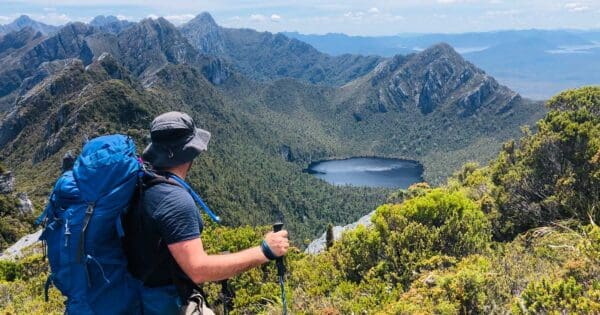Tasmania, Australia’s rugged island state, is a hiker’s paradise. But for those seeking an extra challenge, there’s a special summiting list that beckons: The Abels. Named after Bill Wilkinson, who drew inspiration from Scotland’s Munros, these peaks are Tasmania’s crowning jewels, demanding both physical and mental fortitude.

What are the Abels?
The Abels are a collection of 158 mountains exceeding 1100 meters (3609 feet) in elevation and standing proudly above their surroundings with at least a 150-meter (492 feet) prominence. These aren’t mere hills; they’re teeth in the spine of Tasmania’s wild landscapes, ranging from granite giants like Cradle Mountain to the dolerite sentinels of the South West wilderness.
Climbing all the Abels is part of the Tasmanian peakbagging movement. It’s a badge of honor for Tasmanian and international hikers alike. It’s not just about ticking off summits; it’s about enduring diverse terrains, battling unpredictable weather, and experiencing the raw beauty of Tasmania’s wilderness. Some Abels are day hikes, offering breathtaking views within reach. Others demand multi-day expeditions, testing your camping skills and resilience against the elements.

What Makes a Tasmanian Mountain an “Abel”?
Defining a mountain can be tricky, especially when you’re dealing with a diverse and rugged landscape like Tasmania. But in the 1960s, Tasmanian bushwalker Bill Wilkinson set out to do just that. He wanted to create a list of the state’s true mountains, distinct from mere hills or elevated plateaus.
Wilkinson’s quest for a definitive list of Tasmanian mountains led him to consider several key factors:
- Defining a mountain: What distinguishes a mountain from a hill or plateau?
- Prominence: Should only the most prominent and distinct peaks be included?
- Objectivity and simplicity: The criteria should be clear, measurable, and easy to apply.
After careful deliberation, Wilkinson devised a two-pronged approach to identify Tasmania’s authentic mountains:
- Minimum height: A mountain must reach at least 1,100 meters. This sets a reasonable threshold, ensuring only significant peaks qualify. For reference, Mount Ossa, the highest point in Tasmania, stands at 1,617 meters (5,305 feet).
- Prominence: A mountain within the 1,100-meter threshold must have a minimum drop of 150 meters on all sides before reaching higher ground. This eliminates subsidiary peaks and plateaus, highlighting the most distinct and prominent features.
Wilkinson termed these qualifying peaks “Abels,” a nod to Abel Tasman, the first European explorer to sight the island’s mountainous terrain in 1642. His logbook contains numerous sketches of the peaks he observed from his ship along the Tasmanian coast. Applying these criteria, Wilkinson meticulously analysed maps and compiled a list of 158 Tasmanian peaks that met the “Abel” designation. He documented his findings in the “Abel Tables,” a valuable resource for walkers and outdoor enthusiasts seeking to climb these unique Tasmanian summits.

The Significance of the Abels
For walkers and mountaineers, the Abels offer a finite and achievable challenge. Each peak presents a unique experience, with varying levels of difficulty and stunning scenery. The “Abel Tables” and accompanying “Abel Guides” provide valuable information for planning and undertaking Abel ascents, ensuring a safe and rewarding adventure for all skill levels.
Wilkinson’s “Abel” classification system provides a clear and objective approach to identifying Tasmania’s authentic mountains. It celebrates the island’s unique topography and offers a framework for exploration and appreciation of these awe-inspiring natural landmarks.
Many of the Abels are extremely remote, requiring a lengthy hike into the South West Wilderness, including Federation Peak and Precipitous Bluff. The first person to climb all 158 peaks was in Philip Dawson in 2011, and the first woman was Maureen Martin in 2017.

The Top 10 Abels
Whether you wish to ascend a few Abels, lots of Abels, or all of them, is entirely personal preference. To help get you started, here’s a glimpse of the top 10. Visit The Abel Mountains website for more information and the complete list of the Abels in Tasmania.
- Mount Ossa (1617m)
- Legges Tor (1575m)
- Mount Pelion West (1560m)
- Barn Bluff (1559m)
- Cradle Mountain (1545m)
- Stacks Bluff (1528m)
- Du Cane Range High Point (1520m+)
- Mount Massif (1514m)
- King Davids Peak (1499m)
- Mount Gould (1485m)
Climbing Abels is a journey into the soul of rugged independence. Treasure every step, for the sights, sounds, and scents of this untamed landscape may be fleeting.






So tempting to move to Tassie. While I’m not ambitious enough to want to experience the entire list, I have ticked off quite a few.
Love the Abels!!
Lee Gasser there’s certainly a lot of them to love
Have done Leggs Tor in Ben Lomond
Bonnie Fraser I haven’t done that. Was it a great hike?
Trail Hiking Australia did it June 2022 … there was an early snow … I walked up Jacobs ladder to the ski village and did Leggs Tor from there … was a pretty cool hike … this is a photo at the top …
Media: https://www.facebook.com/photo.php?fbid=8836811012998950&set=p.8836811012998950&type=3
Bonnie Fraser oh that looks very peaceful